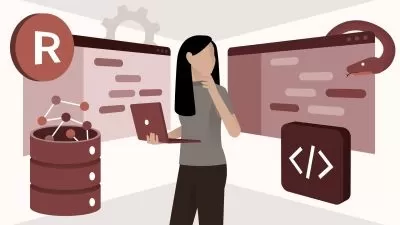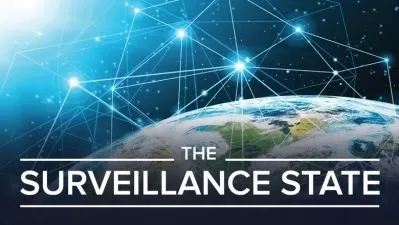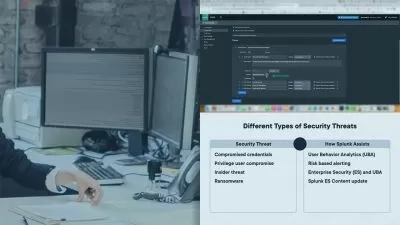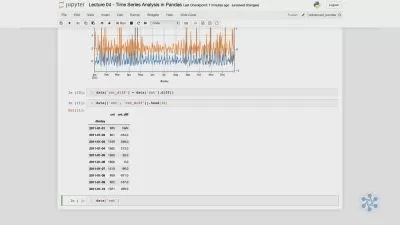Learn Data Science Skills: Python, Pandas, Machine Learning
Skill Tree
6:28:16
Description
Explore tools like : Python,Pandas,Jupyter Notebook, Numpy, Matplotlib, scikit-learn,Seaborn, Machine Learning
What You'll Learn?
- Understand the fundamental concepts of data science.
- Recognize the applications and industry impact of data science.
- Utilize essential data science libraries such as Pandas, NumPy, Matplotlib, and Seaborn.
- Install Python and set up a development environment on Windows and macOS.
- Understand the concept of virtual environments and create/manage them.
- Familiarize with Jupyter Notebook and use it for interactive data analysis.
- Explore and manipulate data using Pandas DataFrames.
- Create and manipulate Pandas Series for efficient data handling
- Load datasets into Pandas and perform initial data inspection and cleaning.
- Transform and analyze data using Pandas methods.
- Visualize data using Matplotlib and Seaborn for insights and reporting.
- Understand supervised, unsupervised, and reinforcement learning techniques.
- Preprocess data for machine learning models, including handling missing values and encoding categorical variables.
- Build, train, and evaluate machine learning models using scikit-learn.
- Measure model performance using metrics like accuracy, confusion matrix, and classification report.
- Deploy a machine learning model for real-time predictions and understand model interpretability techniques.
Who is this for?
What You Need to Know?
More details
DescriptionUnlock the Power of Data Science Skills
In today's data-driven world, the ability to harness and interpret data is not just a valuable skill but a crucial advantage. Whether you're an aspiring data scientist, a seasoned professional looking to expand your skill set, or an entrepreneur aiming to leverage data for strategic decisions, our comprehensive course on data science offers a transformative learning experience.
Course Overview
Our course begins with a foundational exploration of data science, introducing you to its principles and importance in various industries. You'll delve into the distinctions between data science, data engineering, and data analysis, gaining a clear understanding of their respective roles and applications. Through real-world case studies and examples, you'll discover how data science drives innovation and impacts decision-making processes across different sectors.
Essential Tools and Technologies
To equip you with the tools needed for effective data analysis, the course covers essential programming languages such as Python and R. Whether you're manipulating data with Pandas, performing numerical operations with NumPy, or creating insightful visualizations with Matplotlib and Seaborn, you'll develop a versatile skill set that forms the backbone of data science projects.
Practical Skills Development
A significant focus of the course is hands-on learning. You'll gain practical experience in gathering, cleaning, and analyzing data from diverse sources. You'll hone your ability to transform raw data into actionable insights that drive business decisions.
Environment Setup and Best Practices
Navigating the data science environment can be daunting, especially for beginners. That's why we guide you through the setup of Python and Jupyter Notebook on both Windows and macOS, ensuring you're equipped with the right tools from the start. You'll learn to create and manage virtual environments, enhancing your ability to work efficiently and maintain project dependencies.
Data Manipulation and Visualization Mastery
Central to effective data science is the ability to manipulate and visualize data effectively. Our course provides in-depth training in Pandas, where you'll learn to handle complex datasets, perform data transformations, and conduct exploratory data analysis. Through immersive visualization exercises, you'll discover how to communicate insights visually, making complex data accessible and actionable.
Machine Learning Fundamentals
Understanding machine learning is essential for any aspiring data scientist. You'll explore supervised, unsupervised, and reinforcement learning techniques, applying them to real-world datasets. From preprocessing data to training and evaluating machine learning models, you'll develop the skills needed to predict outcomes and optimize performance in various scenarios.
Real-world Applications and Projects
Throughout the course, you'll apply your newfound knowledge to practical projects that simulate real-world challenges. Whether it's predicting house prices using regression models or building a web app for interactive data analysis, these projects provide a platform to showcase your skills and build a professional portfolio.
Career Readiness and Support
Beyond technical skills, we prepare you for success in the competitive field of data science. You'll learn to interpret model performance metrics like accuracy and precision, communicate findings effectively through tools like the confusion matrix and classification reports, and understand the ethical implications of data-driven decisions.
Who Should Enroll?
This course is designed for anyone eager to embark on a journey into data science or enhance their existing skills:
Aspiring Data Scientists: Individuals looking to break into the field and build a strong foundation in data analysis and machine learning.
Professionals Seeking Career Advancement: Data analysts, engineers, and professionals from diverse industries seeking to expand their skill set and transition into data-driven roles.
Entrepreneurs and Business Owners: Leaders interested in leveraging data science to drive strategic decisions and gain a competitive edge in their industry.
Curious Learners: Enthusiasts with a passion for data-driven insights and a desire to understand the transformative potential of data science in today’s world.
Conclusion
By the end of this course, you'll have gained the confidence and skills needed to tackle complex data challenges with proficiency and precision. Whether you're looking to pivot your career, enhance your business acumen, or simply satisfy your curiosity about data science, our comprehensive curriculum and hands-on approach will empower you to unlock the power of data and chart your path to success.
Enroll today and embark on your journey to mastering data science—one insightful discovery at a time.
Who this course is for:
- Aspiring Data Scientists
- Students and Graduates
- Professionals Transitioning Careers
- Data Analysts and Engineers
- Entrepreneurs and Business Owners
- Anyone Curious About Data Science
Unlock the Power of Data Science Skills
In today's data-driven world, the ability to harness and interpret data is not just a valuable skill but a crucial advantage. Whether you're an aspiring data scientist, a seasoned professional looking to expand your skill set, or an entrepreneur aiming to leverage data for strategic decisions, our comprehensive course on data science offers a transformative learning experience.
Course Overview
Our course begins with a foundational exploration of data science, introducing you to its principles and importance in various industries. You'll delve into the distinctions between data science, data engineering, and data analysis, gaining a clear understanding of their respective roles and applications. Through real-world case studies and examples, you'll discover how data science drives innovation and impacts decision-making processes across different sectors.
Essential Tools and Technologies
To equip you with the tools needed for effective data analysis, the course covers essential programming languages such as Python and R. Whether you're manipulating data with Pandas, performing numerical operations with NumPy, or creating insightful visualizations with Matplotlib and Seaborn, you'll develop a versatile skill set that forms the backbone of data science projects.
Practical Skills Development
A significant focus of the course is hands-on learning. You'll gain practical experience in gathering, cleaning, and analyzing data from diverse sources. You'll hone your ability to transform raw data into actionable insights that drive business decisions.
Environment Setup and Best Practices
Navigating the data science environment can be daunting, especially for beginners. That's why we guide you through the setup of Python and Jupyter Notebook on both Windows and macOS, ensuring you're equipped with the right tools from the start. You'll learn to create and manage virtual environments, enhancing your ability to work efficiently and maintain project dependencies.
Data Manipulation and Visualization Mastery
Central to effective data science is the ability to manipulate and visualize data effectively. Our course provides in-depth training in Pandas, where you'll learn to handle complex datasets, perform data transformations, and conduct exploratory data analysis. Through immersive visualization exercises, you'll discover how to communicate insights visually, making complex data accessible and actionable.
Machine Learning Fundamentals
Understanding machine learning is essential for any aspiring data scientist. You'll explore supervised, unsupervised, and reinforcement learning techniques, applying them to real-world datasets. From preprocessing data to training and evaluating machine learning models, you'll develop the skills needed to predict outcomes and optimize performance in various scenarios.
Real-world Applications and Projects
Throughout the course, you'll apply your newfound knowledge to practical projects that simulate real-world challenges. Whether it's predicting house prices using regression models or building a web app for interactive data analysis, these projects provide a platform to showcase your skills and build a professional portfolio.
Career Readiness and Support
Beyond technical skills, we prepare you for success in the competitive field of data science. You'll learn to interpret model performance metrics like accuracy and precision, communicate findings effectively through tools like the confusion matrix and classification reports, and understand the ethical implications of data-driven decisions.
Who Should Enroll?
This course is designed for anyone eager to embark on a journey into data science or enhance their existing skills:
Aspiring Data Scientists: Individuals looking to break into the field and build a strong foundation in data analysis and machine learning.
Professionals Seeking Career Advancement: Data analysts, engineers, and professionals from diverse industries seeking to expand their skill set and transition into data-driven roles.
Entrepreneurs and Business Owners: Leaders interested in leveraging data science to drive strategic decisions and gain a competitive edge in their industry.
Curious Learners: Enthusiasts with a passion for data-driven insights and a desire to understand the transformative potential of data science in today’s world.
Conclusion
By the end of this course, you'll have gained the confidence and skills needed to tackle complex data challenges with proficiency and precision. Whether you're looking to pivot your career, enhance your business acumen, or simply satisfy your curiosity about data science, our comprehensive curriculum and hands-on approach will empower you to unlock the power of data and chart your path to success.
Enroll today and embark on your journey to mastering data science—one insightful discovery at a time.
Who this course is for:
- Aspiring Data Scientists
- Students and Graduates
- Professionals Transitioning Careers
- Data Analysts and Engineers
- Entrepreneurs and Business Owners
- Anyone Curious About Data Science
User Reviews
Rating
Skill Tree
Instructor's Courses
Udemy
View courses Udemy- language english
- Training sessions 81
- duration 6:28:16
- Release Date 2024/07/24



























